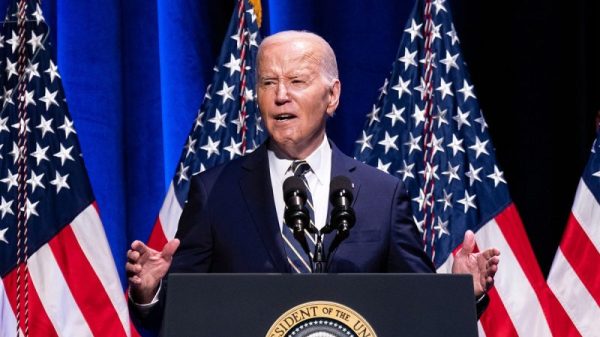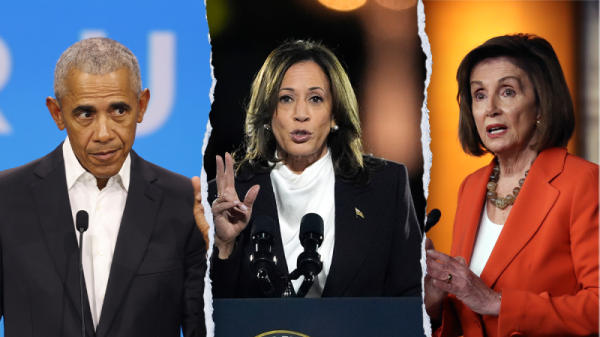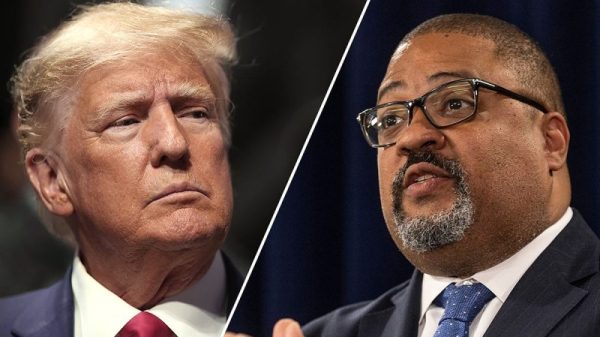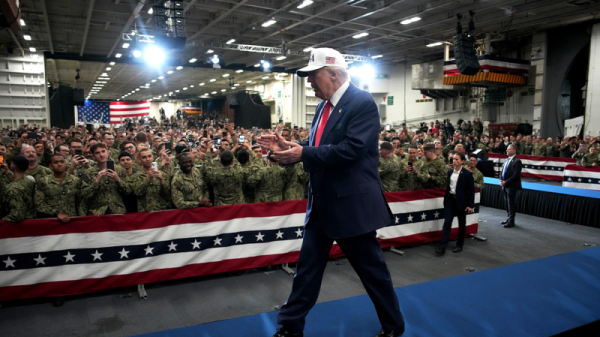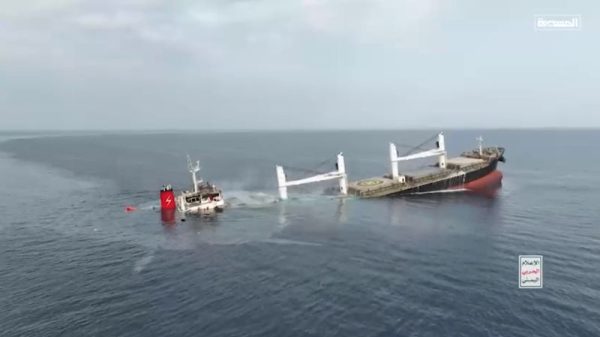
For years the North Korean playbook was obvious to the world. The Democratic People’s Republic of Korea wanted to be the center of attention. If the rest of the world was keeping Washington busy, the reigning Kim (Il-sung, Jong-il, or Jong-un) would seek to force his way into the international conversation.
That sometimes meant hot military action. A US party attacked, a South Korean ship sunk. American soldiers murdered, South Korean sailors drowned. Pyongyang was adept at brutally capturing the limelight.
Along the way, the latter inflicted harm at a retail rate. In 2010, for instance, a South Korean corvette, the ROKS Cheonan, sank, killing 46 of 104 personnel on board. The likely perpetrator was a DPRK midget submarine. Although a terrible crime, thankfully, it was not a precursor to war.
Today the North Korean menace is much greater, with a potential for wholesale killing. In the United States. What is the evidence? The North is refusing to talk with Washington.
The US is worried about the DPRK only because the former is defending the Republic of Korea, with a garrison of 28,500 personnel. This deployment grew out of the Korean War, which ended in an armistice in 1953. Since then, Washington has guaranteed the South’s security from any revived attempt at conquest by the North.
In the early years, South Korea needed help. The war ravaged the South. Seoul was governed by an erratic, aging authoritarian who was upended by popular demonstrations and replaced by a military dictator. At that time both the Soviet Union and People’s Republic of China backed the DPRK and likely would have supported Pyongyang in a military rematch.
By the 1970s, however, The ROK was pulling away economically from its Stalinist adversary. By the late 1980s, democracy came to the South. In contrast, the personality cult of North Korea’s “Great Leader” Kim Il-sung remained suffocating, compared even to those of Joseph Stalin and Mao Zedong. At the same time, the Cold War was coming to an end. The Soviet Union dissolved and the China’s relationship with the West continued to improve.
The evolving geopolitical landscape warranted a change in the Seoul-Washington relationship, a gradual shift in defense responsibilities to South Korea. The ROK still needed to be protected, but not by America. The capability gap between North and South has only continued to grow. The latter has more than 50 times the GDP and twice the population. South Korea has much greater economic and diplomatic heft around the world, and even with China.
Unless one imagines a special geographical feature, perhaps a unique gravitational field, that prevents the country on the peninsula’s south from matching the military of the country on the peninsula’s north, why shouldn’t Seoul develop the capability to deter and, if necessary, defeat Pyongyang? The South is another example of a US client desperate to remain on Washington’s generous defense dole, apparently forever.
Of course, equally ridiculous is the status of Europe and of Japan, which for decades have acted as if they were utterly helpless, constantly wailing for America to do more and reassure them. Even now, when they claim to be thinking about finally acting, they are still demanding that the US prove they are number one in its heart and, more important, its military budget. There is literally nothing America’s allies would not have it do for them. Seoul, at least, puts in more effort than the others, but its sense of entitlement is similar.
Of course, alliance advocates wax eloquent about all the supposed benefits of the relationship: containing China, stabilizing Asia, preventing a regional arms race, retaining close economic and cultural ties, cooperating in other areas, and doing many more great and wonderful things. It’s a fantasy list.
With a new government, Seoul is taking a slightly tougher stance toward the PRC diplomatically, but remains unlikely to turn itself into a missile target by backing US-military operations for any contingency against Beijing other than the ROK’s defense. China is likely to attack South Korea only if the latter chooses to become a combatant on America’s behalf.
In any case, it would be much better for the ROK and Japan to arm themselves than for America to remain between them and Beijing. Indeed, the price of Washington continuing to “stabilize” Asia is a rising likelihood of war with the PRC. Allied and friendly states should create their own capable militaries and work together to deter China, with the US backstopping their continued survival as independent states, not micro-managing disputes over who controls which barren rocks in which sea. Better an arms race excluding, rather than including, America.
Finally, most forms of cooperation, both existing and possible, between Washington and Seoul have nothing to do with a military alliance. Personal, cultural, and economic ties between the two nations are strong. These relationships could continue even if military relations were much looser, based on cooperation on shared interests.
Yet, seven decades after the conclusion of the Korean War, Americans are still responsible for the defense of the South. Hence, Americans remain a target of the North. And Pyongyang has been diligently strengthening its geopolitical position.
North Korea’s links with China remain strong, with the latter playing defense at the United Nations, blocking US attempts to sanction the DPRK for its missile tests. Kim has revived his nation’s relations with Moscow. He unreservedly backs its invasion of Ukraine, and apparently is supplying Russia with artillery ammunition. The North also recently revived rail traffic between the old Cold War allies.
Of much greater concern, Pyongyang has been racing ahead militarily. “The world,” as in a small-but-committed band of DPRK-watchers, is waiting for an expected seventh nuclear test. The betting is that North Korea is miniaturizing its warheads and hopes to deploy tactical nukes to enhance its defense against the vastly stronger conventional forces of the South and US.
Even more dramatic has been the upsurge in DPRK missile testing. So far this year the North is at roughly 80, ten times the number launched last year. Most ominously, Pyongyang appears determined to develop submarine-launched ballistic missiles and intercontinental ballistic missiles. The former would strengthen North Korea’s deterrent against a preemptive strike, and the latter would place the American homeland within the DPRK’s reach.
At the same time, North Korea refuses to talk, a truly disturbing break from recent behavior. Pyongyang once seemed eager to receive a geopolitical marriage proposal, but no longer. Like a besotted lover, the Biden administration has thrown itself at Kim, begging him to negotiate, but he has rudely rebuffed the administration. Indeed, Kim and especially his sister, have treated allied entreaties with contempt, as if signs of weakness. There is little more Washington can do, other than “strengthen” its alliance with the South further, making the latter even more dependent on America. For instance, Seoul wants Washington to return tactical nuclear weapons to the peninsula.
Presumably Pyongyang is building up its arsenal to give it leverage in future negotiations. The potential bottom line is frightening. For instance, the Asan Institute and Rand Corporation posited: “by 2027, North Korea could have 200 nuclear weapons and several dozen intercontinental ballistic missiles (ICBMs) and hundreds of theater missiles for delivering the nuclear weapons. The ROK and the United States are not prepared, and do not plan to be prepared, to deal with the coercive and warfighting leverage that these weapons would give North Korea.”
This doesn’t mean the North would start a preventive war against America. US retaliation would be sure and overwhelming. However, such a DPRK buildup would mean Washington’s support for the South, even purely conventional to start, would risk nuclear retaliation. If North Korea faced defeat, Kim would have little incentive not to go for broke, “unleashing hell” and hoping for a miracle.
Imagine allied forces breaking free and heading for the Yalu River border with China, like in 1950. This time Beijing probably would keep its troops in their barracks. If so, what if Kim announced that the allies had 24 hours to begin withdrawing, else he would target US cities? Imagine if Pyongyang had a score or more solid-fuel ICBMs with multiple warheads for use against America, a couple submarines carrying SLBMs possibly off America’s coast, and numerous shorter-range missiles capable of hitting Guam, the Commonwealth of Mariana Islands, and US bases in Japan, the Philippines, Australia, and South Korea. How could a president not comply?
Of course, the North’s capabilities might not be so clear. Would the president dare to call what he believed to be a bluff? What if he concluded there was a high probability that at least one nuclear-armed missile was likely to get through? How many American cities and lives would he be prepared to risk? The price of guessing wrong would be catastrophic.
The status quo is becoming untenable. Extended deterrence, Washington’s willingness to defend the ROK with every weapon at its disposal, including nukes, was announced when the DPRK had no means to strike America. US military personnel deployed to the peninsula would be vulnerable, but the homeland was secure. In the not-too-distant future, that will no longer be the case with North Korea.
Which makes it imperative to convince Pyongyang to talk. That likely requires making clear that while Washington still desires denuclearization, it no longer will make that a requirement for negotiations. The US might sweeten its offer by ending the travel ban to the DPRK, offering to open liaison offices, and suggesting some sanctions that could be suspended in return for the North’s agreement to initial arms control measures.
Even more important, Washington should begin shifting responsibility for the South’s defense to the South, where it belongs. The American defense guarantee made sense in 1953, when the “Mutual” Defense Treaty was inked. Today, with the ROK taking its place among the world’s most successful democracies, not so much.
The best way to enhance America’s security is for its defense-dependents to graduate and take care of themselves and their own regions. With the US off the peninsula, Pyongyang wouldn’t much care about affairs in Washington.
Moreover, with federal finances doomed to even-greater strain as the population continues to age, the US can no longer afford to act a global sugar daddy for rich friends, like the ROK, enjoying the good life at Americans’ expense. The ominous silence enveloping Pyongyang makes South Korea a good place to start Washington’s long goodbye to its unofficial role as globocop.











